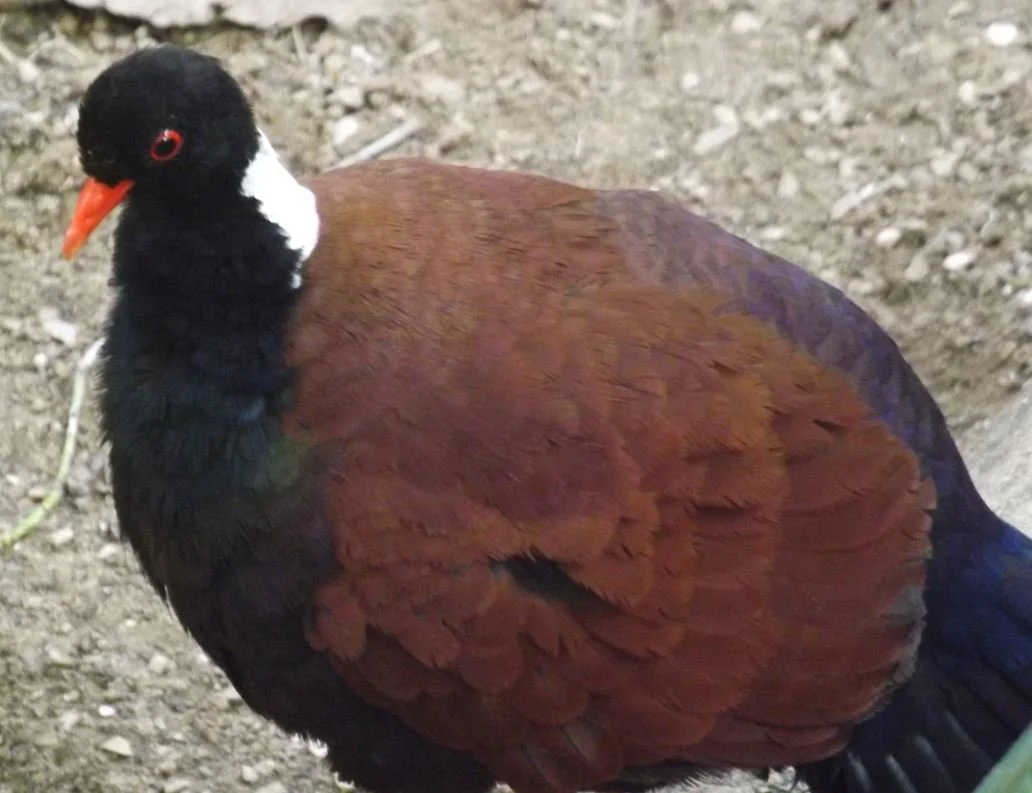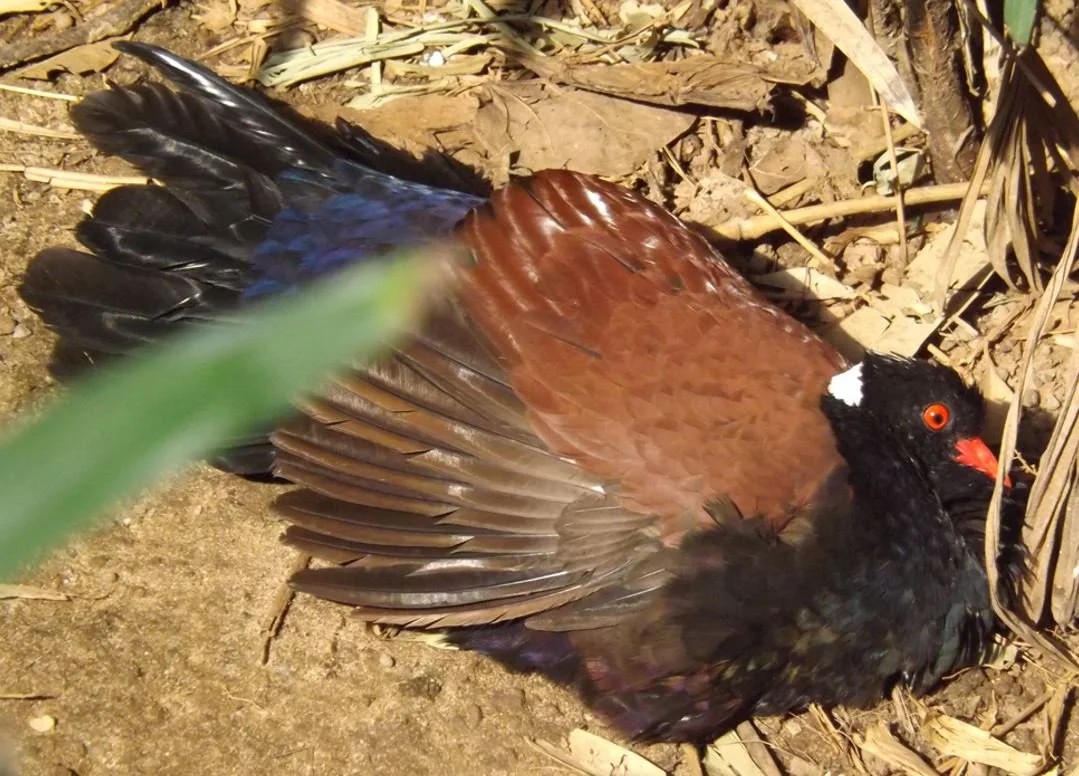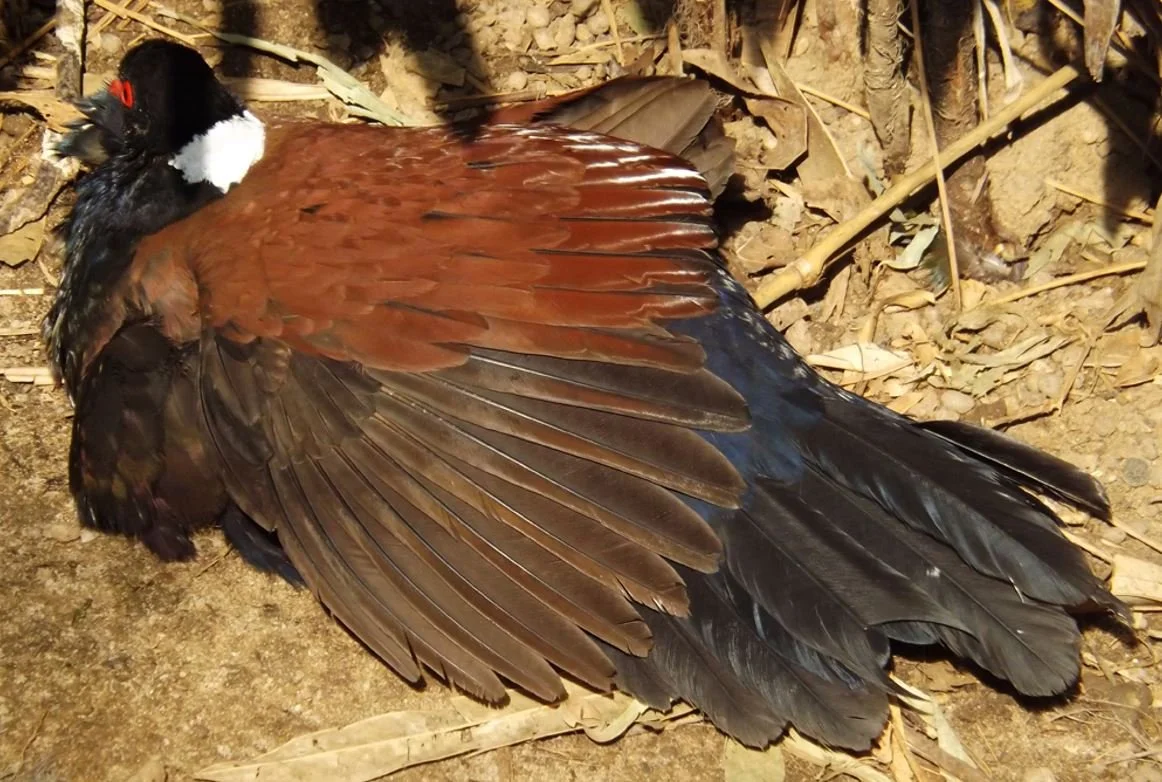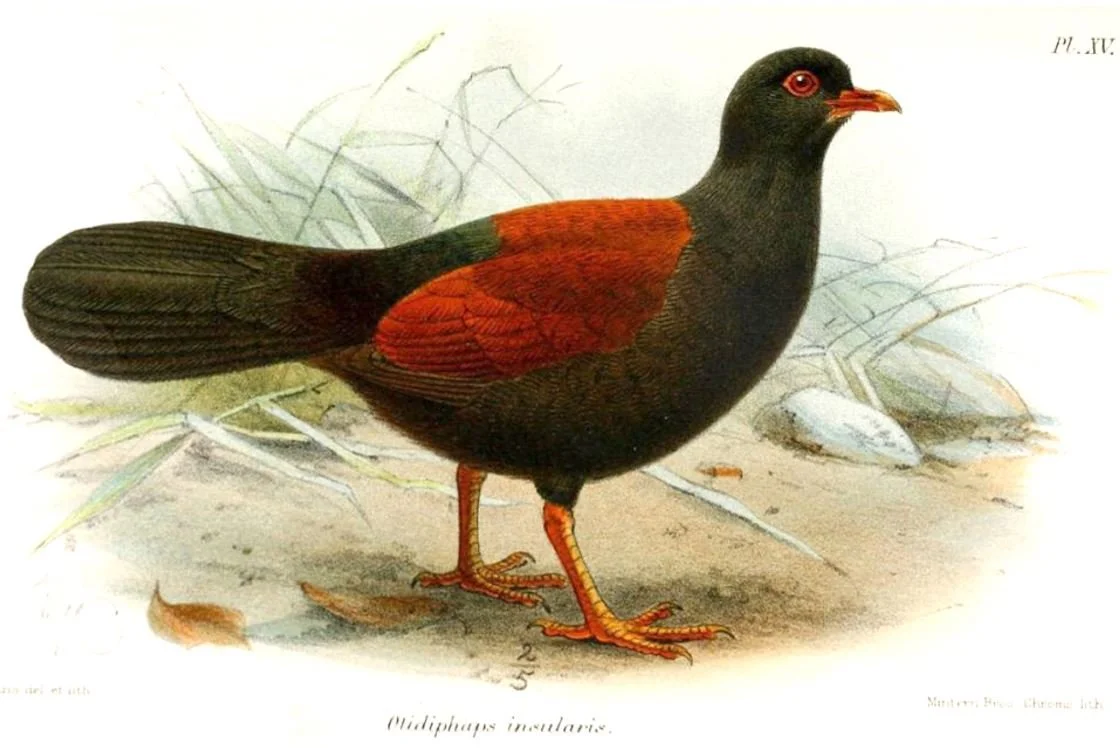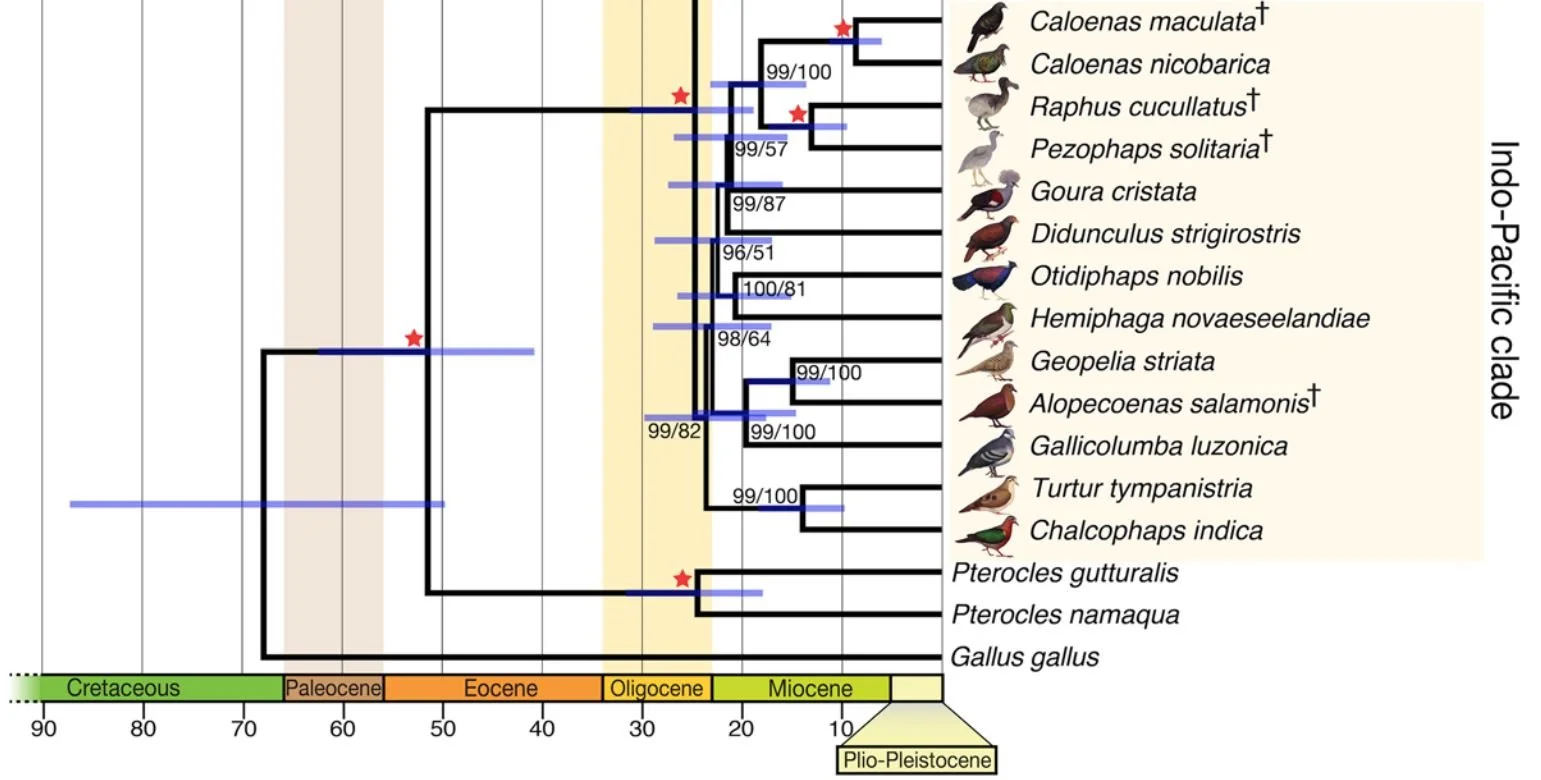I like pigeons….
Caption: some representation of pigeon diversity. From left to right: a crowned pigeon (Goura), Nicobar pigeon (Caloenas), wood pigeon (Columba). Images: Darren Naish.
… they’re a diverse, globally distributed group that have done a surprising number of things in their evolutionary history, and I’ve written about some of their diversity here at TetZoo (see links below). In this article I want to talk about Otidiphaps nobilis, the Pheasant-pigeon: one of several pigeon taxa that is surprisingly large relative to what we’re ‘used to’ (our standard reference is – I think it’s fair to say – the domestic or feral form of the Rock dove Columba livia).
Caption: the bulk and size of Otidiphaps is obvious from this photo. White-naped pheasant-pigeons have proved relatively easy to breed in captivity and most of our knowledge of pheasant-pigeon biology and behaviour is based on what’s happened in European collections. Image: Darren Naish.
Otidiphaps is endemic to New Guinea and the surrounding islands, including the Aru Islands to the south-west, Batanta and Waigeo in West Papua province, and Fergusson Island in the D’Entrecasteaux Islands to the east of New Guinea. It’s large – about similar in size to a small domestic chicken at 50 cm in length and 500 g – and clearly ground-adapted, with long legs, short, rounded wings, a highly reduced furcula (wishbone) and a uniquely long, laterally compressed tail that’s substantially bigger than what you’d expect for a pigeon. It can fly and takes off with a loud clattering noise. I assume (but cannot confirm) that the generic name – coined by John Gould in 1870 – combines the generic word for the great bustard (Otis, originally referring to the feathery ‘ears’ of this bird) with phaps for wild pigeon, making this the ‘bustard pigeon’.
These are birds of montane forests and lowlands, and they appear reliant on seeds and fallen fruit. Pebbles have been found as stomach contents too: were these gastroliths or swallowed by mistake? They’re ground-nesters that produce a single egg; the sexes look similar and both incubate the egg and care for the chick. A loud ‘wu-huowooooa’ or ‘moaning coo’ (Goodwin 1967) that travels some distance is characteristic, but they also make more conventional cooing sounds.
Caption: sun-bathing White-naped pheasant-pigeon, photographed at Marwell Wildlife in 2022. The bright red bill and eye are distinctive, and note the glossy nature of many of the wing and tail feathers. Image: Darren Naish.
Caption: the same individual shown above, but this time facing the other way. Frayed and worn feather-tips are typical for ground-dwelling birds. The tail is formed of 20-22 rectrices; 12-14 is more typical for pigeons. Image: Darren Naish.
Otidiphaps: not monotypic! I long thought that the whole species was known as the ‘White-naped pheasant-pigeon’ since all the specimens I’ve seen in captivity have white napes and have been labelled with this name. However, white-napedness is characteristic of the Aru Islands population (O. n. aruensis). Western New Guinea is home to the Bronze-naped or Green-naped pheasant-pigeon O. n. nobilis, which also differs from the white-naped form in having a feathery crest. In south-eastern New Guinea, the grey-naped O. n. cervicalis occurs. It also seems to have a crest. Finally, a form with a black nape – generally regarded as a separate species; the Black-naped pheasant-pigeon O. insularis – is known only from the type specimen collected on Fergusson Island in 1882. Because eyewitness reports have been made since the 1880s, it’s said in some texts to still be around, just very rare. However, Gregg et al. (2020) failed to find any trace of it despite targeted searches using camera traps. As slow breeding ground-nesters mostly dependent on primary forest, these birds are of course vulnerable to hunting and other pressures.
Caption: captive Green-naped pheasant-pigeon at Bristol Zoo. This image provides a good view of the large scutes on the legs and feet. Image: Adrian Pingstone, in public domain (original here).
Having said that the Black-naped pheasant-pigeon is sometimes regarded as a distinct species, I should note that species status has been suggested for all the taxa mentioned here.
Caption: John G. Keulemans’ image of a Black-naped pheasant-pigeon in life. Image in public domain.
Phylogeny. While there are a few other vaguely quail-like or pheasant-like pigeons, Otidiphaps is considered so distinct that experts have struggled to pin down its affinities. Some have considered it worthy of its own family or subfamily – Otidiphapidae and Otidiphabinae [sic] are both in the literature – and assessments of its morphology have generally placed it close to crowned pigeons (Goura) and kin, and to fruit pigeons (Goodwin 1967, Janoo 1996). Molecular studies that have incorporated it have mostly found it to be part of the same clade as the Gallicolumba ground doves (a horrendously paraphyletic group, by the way), crowned pigeons (Goura) and Nicobar pigeons (Caloenas) (Pereira et al. 2007, Gibb & Penny 2010, Fulton et al. 2012, Soares et al. 2016) within the Indo-Pacific pigeon clade. This also makes it close to dodos and solitaires. As tempting as it may then be to imagine this lot forming some sort of ‘Big Terrestrial’ pigeon assemblage, things aren’t that simple, since the large fruit pigeon clade (Ptilinopinae) belongs here too, and one of the most comprehensive studies (Soares et al. 2016) found Otidiphaps to be closer to fruit pigeons that it is to the ‘dodo clade’ (Gourinae or Diduculinae).
Caption: the Indo-Pacific segment from Soares et al.’s (2016) phylogeny. Pheasant-pigeons emerge as the sister-group to fruit pigeons, here represented by Kererū or New Zealand pigeon Hemiphaga novaeseelandiae. Note that virtually all of the lineages here originated deep in the Miocene.
These results indicate that Indo-Pacific pigeons didn’t take to ‘galliform-like’ life on one occasion, but on four or more times independently over the past 20 million years (Soares et al. 2016) (something we would assume anyway, given the far-flung distributions of the lineages in question). It might be that this happened whenever pigeons found themselves adapting to terrestrial life on islands devoid of pheasant-like birds (a complication: megapodes occur in New Guinea and nearby and are vaguely ‘pheasant-like’).
And... as tempting as it may be to imagine that all big, terrestrial pigeons had or have the potential to evolve into flightless, dodo-like giants – descendants of the long-legged ‘bustard pigeon’ might seem especially prone to that – the fact is that many of these birds still require flight, and have not evolved in settings quite like those of the Mascarenes.
And we’ll end things there. For previous TetZoo articles on pigeons, see…
The detachable tails of pigeons, September 2008
Are parrots actually pigeons?, May 2009
Giant club-winged pigeons and ninja ibises: clubs, spurs, spikes and claws on the hands of birds (part III), February 2011
Footless Urban Pigeons Suffer Untold Trials and Tribulations, September 2014
Voyeurism and Feral Pigeons, June 2015
The Asian Dove That Ate Europe Alive, January 2017
Pigeons and Doves 101, March 2018
The Dodo in Life, July 2020
Refs - -
Fulton, T. L., Wagner, S. M. & Shapiro, B. 2012. Case study: recovery of ancient nuclear DNA from toe pads of the extinct Passenger pigeon. Methods in Molecular Biology 840, 29-35.
Gibb, G. C. & Penny, D. 2010. Two aspects along the continuum of pigeon evolution: a South-Pacific radiation and the relationships of pigeons within Neoaves. Molecular Phylogenetics and Evolution 56, 698-706.
Goodwin, D. 1967. Pigeons and Doves of the World. Trustees of the British Museum (Natural History), London.
Gregg, J., Nason, D. & Boersma, J. 2020. Survey of the montane avifauna of Fergusson Island, Milne Bay Province, Papua New Guinea. Bulletin of the British Ornithologists’ Club 140, 309-320.
Janoo, A. 1996. On a hitherto undescribed dodo cranium, Raphus cucullatus L. (Aves, Columbiformes), with a brief taxonomical overview of this extinct flightless Mascarene Island bird. Bulletin du Muséum national d’Histoire naturelle, Paris 4e série, 18, Section C, no 1, 57-77.
Pereira, S. L., Johnson, K. P., Clayton, D. H. & Baker, A. J. 2007. Mitochondrial and nuclear DNA sequences support a Cretaceous origin of Columbiformes and a dispersal-driven radiation in the Paleogene. Systematic Biology 56, 656-672.
Soares, A. E. R., Novak, B., Haile, J., Heupink, T. H., Fjeldså, J., Gilbert, T. P., Poinar, H., Church, G. M. & Shapiro, B. 2016. Complete mitochondrial genomes of living and extinct pigeons revise the timing of the columbiform radiation. BMC Evolutionary Biology 16: 230.


